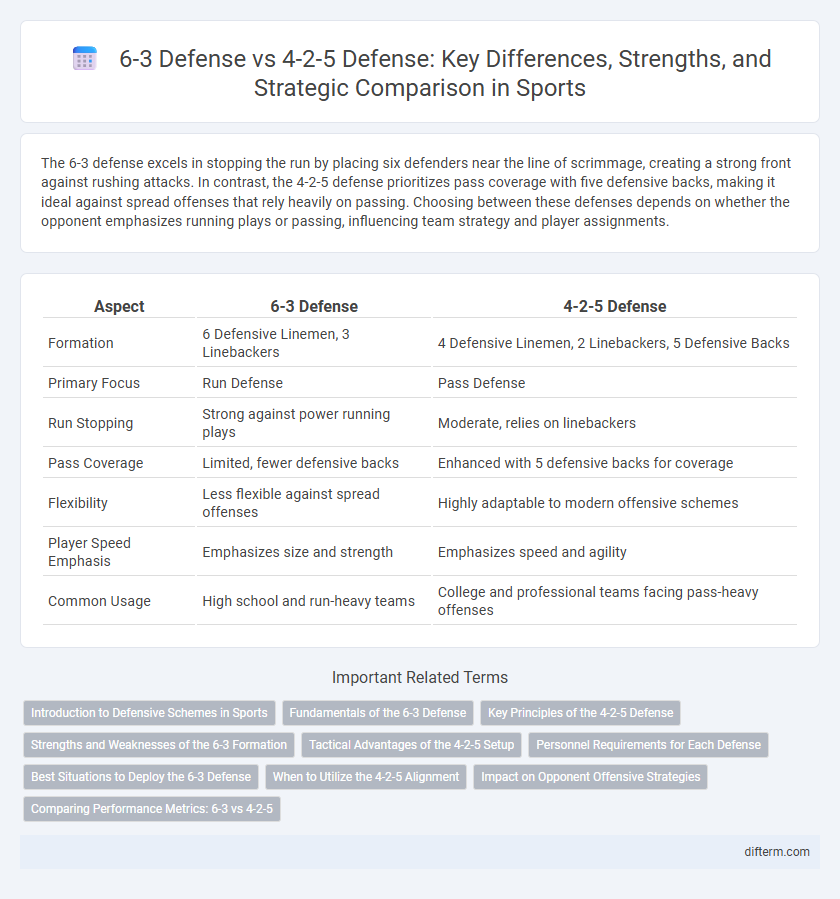The 6-3 defense excels in stopping the run by placing six defenders near the line of scrimmage, creating a strong front against rushing attacks. In contrast, the 4-2-5 defense prioritizes pass coverage with five defensive backs, making it ideal against spread offenses that rely heavily on passing. Choosing between these defenses depends on whether the opponent emphasizes running plays or passing, influencing team strategy and player assignments.
Table of Comparison
| Aspect | 6-3 Defense | 4-2-5 Defense |
|---|---|---|
| Formation | 6 Defensive Linemen, 3 Linebackers | 4 Defensive Linemen, 2 Linebackers, 5 Defensive Backs |
| Primary Focus | Run Defense | Pass Defense |
| Run Stopping | Strong against power running plays | Moderate, relies on linebackers |
| Pass Coverage | Limited, fewer defensive backs | Enhanced with 5 defensive backs for coverage |
| Flexibility | Less flexible against spread offenses | Highly adaptable to modern offensive schemes |
| Player Speed Emphasis | Emphasizes size and strength | Emphasizes speed and agility |
| Common Usage | High school and run-heavy teams | College and professional teams facing pass-heavy offenses |
Introduction to Defensive Schemes in Sports
The 6-3 defense features six defensive linemen and three linebackers, emphasizing run-stopping power and controlling the line of scrimmage. The 4-2-5 defense uses four linemen and two linebackers alongside five defensive backs to strengthen pass coverage and adapt to spread offenses. Both schemes balance pressure and coverage differently to counter specific offensive strategies in football.
Fundamentals of the 6-3 Defense
The 6-3 defense emphasizes strong run-stopping capabilities by deploying six defensive linemen and three linebackers, creating a formidable front against rushing plays. This alignment relies on gap control, leverage, and disciplined off-tackle pursuit to disrupt offensive blocking schemes. Players must maintain proper tackling fundamentals and read the offensive formation effectively to prevent big plays and dominate line-of-scrimmage battles.
Key Principles of the 4-2-5 Defense
The 4-2-5 defense emphasizes speed and versatility by deploying four defensive linemen, two linebackers, and five defensive backs to effectively counter modern spread offenses. This alignment prioritizes pass coverage with an extra defensive back while maintaining run defense integrity through aggressive linebacker play and strong front four pressure. Key principles include adaptable coverage schemes, rapid downfield defensive adjustments, and enhanced ability to disguise blitzes, making it optimal against pass-heavy and option-based offenses.
Strengths and Weaknesses of the 6-3 Formation
The 6-3 defense excels in stopping powerful running games due to its emphasis on six defensive linemen, creating a strong front to clog rushing lanes and collapse pockets quickly. However, its main weakness lies in vulnerability against passing attacks, especially against teams deploying multiple wide receivers, as fewer defensive backs limit coverage flexibility and speed in the secondary. This formation is best suited for short-yardage and run-heavy situations but struggles against spread offenses that exploit its lighter pass defense.
Tactical Advantages of the 4-2-5 Setup
The 4-2-5 defense excels in pass coverage by deploying five defensive backs, which enhances versatility against spread offenses and multiple receiver sets. Its two linebackers provide a balanced approach, allowing effective run support while maintaining strong pass defense capability. This tactical alignment increases adaptability to both zone and man-to-man coverage schemes, improving overall defensive responsiveness.
Personnel Requirements for Each Defense
The 6-3 defense requires six defensive linemen and three linebackers, emphasizing a strong front to stop the run and control the line of scrimmage. The 4-2-5 defense uses four defensive linemen and two linebackers, augmented by five defensive backs to better handle passing offenses. Personnel for the 6-3 defense typically includes larger, more physical linemen, while the 4-2-5 demands versatile defensive backs and faster linebackers to cover more ground.
Best Situations to Deploy the 6-3 Defense
The 6-3 defense excels against run-heavy offenses, effectively controlling the line of scrimmage with six down linemen and three linebackers to plug gaps and stop inside runs. This formation is ideal in short-yardage and goal-line situations where preventing ground gains is critical. Teams deploying the 6-3 defense maximize gap integrity and leverage physicality to disrupt power-running schemes and limit inside scoring opportunities.
When to Utilize the 4-2-5 Alignment
The 4-2-5 defense excels against spread offenses by providing extra defensive backs for enhanced pass coverage, making it ideal in obvious passing situations or against teams with multiple wide receivers. This alignment increases flexibility in defending both the run and the pass, especially when facing mobile quarterbacks or prioritizing speed on the field. Coaches often deploy the 4-2-5 in third-and-long scenarios to disrupt passing lanes and apply pressure without sacrificing coverage.
Impact on Opponent Offensive Strategies
The 6-3 defense, with six linemen and three linebackers, primarily stifles the run by clogging running lanes and forcing offenses to rely more on short passes or outside runs, limiting big-play opportunities. In contrast, the 4-2-5 defense, featuring four linemen and five defensive backs, excels against pass-heavy offenses by providing enhanced pass coverage and flexibility to counter spread formations and quick throws. Opponents face a tougher aerial attack against the 4-2-5 but may find more running lanes compared to the 6-3's run-focused front, shaping offensive play-calling to exploit perceived vulnerabilities.
Comparing Performance Metrics: 6-3 vs 4-2-5
The 6-3 defense excels in run-stopping with six linemen and three linebackers, often outperforming the 4-2-5 in rushing yards allowed per game, averaging around 90 yards compared to 120. In pass defense, the 4-2-5, with five defensive backs, reduces passing yards and increases interceptions, yielding an average of 220 passing yards allowed versus 270 in the 6-3. Overall, the 4-2-5 offers superior pass coverage metrics, while the 6-3 maintains an edge in run defense efficiency.
6-3 defense vs 4-2-5 defense Infographic

 difterm.com
difterm.com